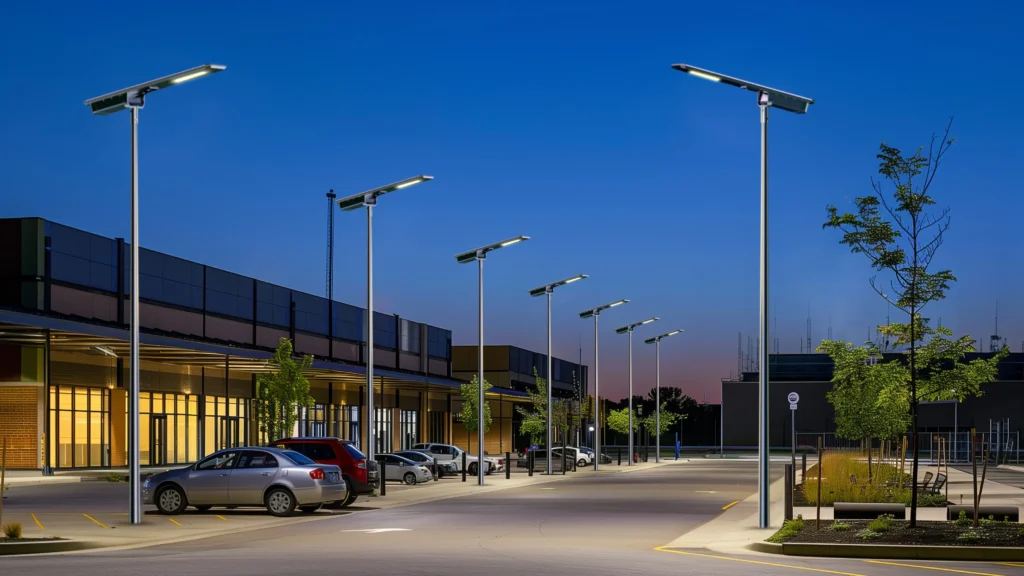With the global transition to green energy, solar streetlights are becoming a key component of sustainable urban infrastructure. The use of ambient light sensors, particularly through automatic brightness adjustment technology, significantly improves the energy efficiency of solar streetlights. This article details the application of ambient light sensors in solar streetlights, focusing on how the Sresky ATLAS MAX series helps international B2B customers—such as wholesalers, distributors, retailers, and engineering buyers—optimize their energy efficiency with this innovative technology.

1. The Working Principle and Importance of Ambient Light Sensors
An Ambient Light Sensor (ALS) detects the intensity of surrounding natural light and automatically adjusts the brightness of streetlights according to changes in ambient light. This intelligent adjustment not only conserves energy but also ensures adequate lighting at night or in low-light conditions.
In traditional lighting models, streetlights often operate at maximum brightness throughout the night, regardless of actual light needs, leading to significant energy waste. With ALS, solar streetlights dynamically adjust to real-time light demands, maximizing energy savings while ensuring safety.
- Key Advantages of ALS:
- Energy Saving Optimization: Reduces unnecessary energy consumption by adjusting brightness based on ambient light.
- Extended Battery Life: Minimizes power consumption and prolongs battery life when high brightness is unnecessary.
- Improved User Experience: Ensures stable and reliable lighting, enhancing the safety and convenience of neighborhoods and commercial areas.
2. Ambient Light Sensor Application in Sresky ATLAS MAX Series
The Sresky ATLAS MAX series is a leader in solar streetlight technology, incorporating advanced ALS 2.4 technology that automatically adjusts light brightness, saving energy while maintaining excellent lighting performance. The ATLAS MAX’s ALS 2.4 technology adjusts light output based on real-time ambient light intensity, especially in cloudy or low-light conditions, to ensure stable and reliable illumination while significantly reducing energy consumption.
- The ATLAS MAX Features:
- ALS 2.4 Intelligent Dimming Technology: Automatically adjusts brightness according to the real-time environment, ensuring intelligent regulation.
- Dual Color Temperature Adjustment Function: Allows for adjustment between warm and cool light based on environmental needs to suit various scenes and lighting requirements.
- Temperature Control System (TCS): Works with ALS to keep the battery within an optimal temperature range through effective heat dissipation, preventing overheating and extending device lifespan.

3. The Role of Ambient Light Sensors in Energy Saving
Energy saving is a key challenge for solar streetlights. Typically, streetlights operate at maximum brightness at night, which may not be necessary at all times, especially during different stages of the night or when ambient light levels are sufficient. ALS can significantly reduce the burden on batteries and solar panels by automatically adjusting light brightness, thereby extending the operational time of the streetlight.
For instance, during twilight hours or moonlit nights, ALS can reduce light brightness to the minimum required level, thus minimizing unnecessary energy waste.
- Energy Saving Benefits in Concrete Terms:
- 30% Energy Consumption Savings: ALS can adjust brightness during cloudy or rainy days, saving up to 30% of energy compared to traditional solar streetlights.
- Extended Lighting Time: Intelligent regulation allows solar streetlights to maintain continuous lighting for up to 7 nights, even during prolonged cloudy periods.
4. Potential Applications for Ambient Light Sensors in Different Markets
Applying ALS technology to solar streetlight projects not only aids in energy saving but also reduces maintenance costs and enhances overall project efficiency. There is a growing global demand for solar streetlights, especially in urban and commercial projects promoting sustainable development and reducing carbon footprints.
- Applicable Markets Include:
- Urban Infrastructure Projects: Cities increasingly opt for ALS-controlled solar streetlights in their sustainability plans.
- Smart City Construction: ALS’s smart dimming capabilities are crucial for smart city infrastructure, enabling intelligent energy management and automation.
- Commercial and Industrial Projects: Large commercial and industrial parks require energy-efficient and low-maintenance lighting systems, which solar streetlights with ALS technology can provide.
5. Why Choose Sresky ATLAS MAX Series Solar Street Lights?
The Sresky ATLAS MAX series sets new industry standards for energy efficiency and performance. Its integrated ALS technology makes it a reliable and cost-effective long-term solution. Additionally, the ATLAS MAX features a seamless design, dual-layer physical insulation, and a 6-year warranty, ensuring long-lasting and consistent illumination even in extreme environments.
- Product Highlights:
- High Brightness Output: Up to 15,400 lumens, ensuring efficient lighting of large areas.
- Monocrystalline Silicon Solar Panel: Efficient energy harvesting for continuous power supply.
- LiFePO4 Battery Technology: Equipped with over-charging and over-discharging protection for longer battery life.
- Intelligent Remote Control Operation: Multiple lighting modes simplify the operation process.
The application of ambient light sensors in solar streetlights, particularly in the Sresky ATLAS MAX series, highlights the potential of intelligent energy-saving lighting. By adjusting brightness in real-time, ALS technology effectively reduces energy waste, extends battery life, and ensures consistent illumination under varying environmental conditions. The Sresky ATLAS MAX is an ideal choice for organizations seeking a reliable, energy-efficient, and sustainable lighting solution. Join Sresky in leading the green future of solar street lighting!